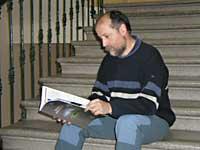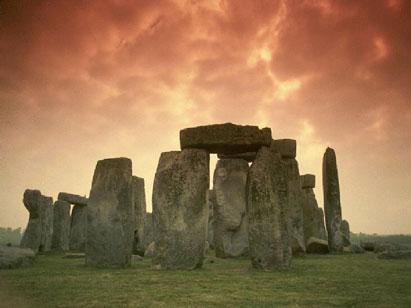Open museums of the heritage of the past
2008/05/01 Kortabitarte Egiguren, Irati - Elhuyar Zientzia Iturria: Elhuyar aldizkaria
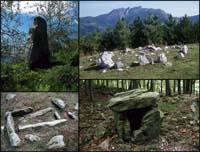
In the megaliths you can find much information about our ancestors: how they were, where they came from, how they lived... But most of the megaliths that have gotten rid of the slaughter from prehistory to the present are still in a lamentable situation; few are still proud of the earth.
To stop this continued loss, the Department of Culture of the Basque Government declared all the megaliths of Gipuzkoa and the megalithic stations that composed them in 2003 as cultural assets and established their protection regulations. However, the road to achieving this pioneering designation has not been slow. To find the beginning of the tour we must go back until 1979, when the Aranzadi Science Society began to place signs in the megaliths known in Gipuzkoa. In this work and under the direction of the archaeologist Jesús Altuna began, among others, Luis del Barrio, currently a member of the company Lurrailan.
Monuments management
He collaborates with the Department of Rural Development of the Provincial Council of Gipuzkoa in the archaeological review of forest activities in Lurrail. Also Luis del Barrio, whose job is to be with the City Councils, that is, to inform the City Councils of the megalithic assets they have in their lands and to make them see the need for their conservation and protection. It also proposes a series of actions for the cleaning of these monuments without moving.
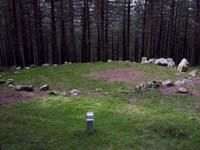
There are many municipalities that do not know the existence of this type of precious stones in their lands and do not pay much attention to this initiative. Other municipalities of Hondarribia, Oiartzun, Astigarraga, Hernani, Urnieta, Andoain, Zizurkil, Orereta, Getaria, Getaria, Soraluze, Elgoibar, Villabona, Deba and Zestoa have eagerly taken the initiative to recover them.
In any case, after the declaration by the Basque Government in 2003 of all the megaliths of Gipuzkoa as a cultural asset and the establishment of the protection regulations, all the megaliths of Gipuzkoa have been cleaned and marked by a colonnade with the subsidy of the municipalities and the Department of Culture of the Basque Government.
All the herbs and scrubs surrounding all megaliths are cleaned by hand or with scissors and then removed all that grass with the help of blowers not to move any of the stones of these monuments. The megalito is thus quite clean and visible.
The signs of the megaliths are of grey limestone of Deba, of size 1 x 0.23 x 0.16 meters and rise half a meter of the ground. On them there is an informative sheet of megalito in stainless steel carved, darkened and embossed. As you can see, the toughest materials have been used to make them as durable as possible. In addition to the information of each megalith, they report through plans of megalithic sets or megalithic stations.
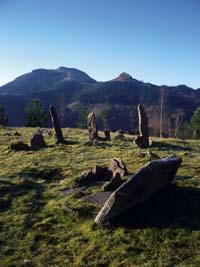
In the megaliths three protection zones are distinguished: the first is the surface on which the megalito sits; the second, the area that extends to 10 meters around the megalito; and the third, the megalithic station itself, which is the most extensive area where the megalithic set is located.
The first and second zones are quite controlled and monitored, while in the third zone, being more extensive, it is more difficult to control forestry activity or the construction of forest tracks, for example. However, the Department of Culture and Euskera of the Provincial Council of Gipuzkoa takes action.
Various
In Gipuzkoa 260 points are known in which there are megaliths, in which there are 368 megaliths, in 28 megalithic stations. XIX. At the end of the 20th century was discovered the first megalith of Gipuzkoa, the first dolmen of Gipuzkoa. However, among the megaliths that the ancestors worked and built with their hands, in addition to the dolmens, there are tumuli, tracks, orchards and monoliths.

The famous dolmens are collective tombs to bury the dead, built by human groups of pastoral environment, especially in the Copper Age and the Bronze Age. They are large standing stones that form a funerary chamber. In most cases they were covered with another wide stone. Inside the chamber they buried the deceased with their weapons, tools and various ceramic containers filled with food. Sometimes everything was covered with stones and earth forming a summit called tumulus. There are also tumuli without a camera, also tombs.
For a long time it was thought that in the tombs were buried treasures. Therefore, today, except for exceptions, they appear deteriorated and disfigured by the searches of treasures. They have also been used for the construction of stone walls, booths, etc. However, some dolmens are perfectly preserved, such as the Collado de Sagastieta.
The cromlech are also tombs, which collect the ashes of the dead. They belong to the same time as the dolmens, but they had a more extensive use than the latter, since in the Iron Age the ashes were kept. However, over time the same model has remained. These are stone circles, usually 5-6 meters in diameter. The stones or witnesses that form the orchard are called ortostatos. The number of stones is not always the same. In the center the ashes of the deceased are preserved.
Monoliths or menhirs are long stones of different sections. They are placed vertically on the ground, but some have fallen over time and today we find them lying on fields. They are more recent than the Moors' orchards and do not know what their goal was. They may be man-carried stones from one place to another. However, according to expert Luis del Barrio, perhaps these are stones used to highlight and mark something that once happened in these media, such as someone's death. If we ask grandparents, more than one will say that those stones have been thrown by the Gentiles, because they have heard their parents these stories. These stones were used to attack Christians. Therefore, they are also known as gentilarri.
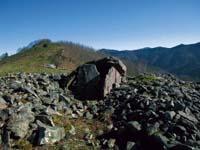
In general, all these monuments built to the dead appear throughout the Basque Country and are of very different sizes. Unfortunately, the legal situation of the megalithic heritage is different in each territory of Euskal Herria; however, we cannot deny that the denominations and works made in Gipuzkoa can be an unbeatable starting point to preserve the old stones of our ancestors. Knowing the existence of this monumental heritage is essential to understand and enjoy our past, as well as to properly preserve it and transmit it to the generations to come.

Gai honi buruzko eduki gehiago
Elhuyarrek garatutako teknologia



